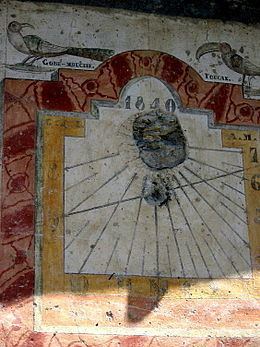 | ||
Giovanni Francesco Zarbula was a mural painter and sundial designer from Piedmont Italy who created a hundred or more vertical and vertical declining sundials in the French and Italian Alpes between 1830 and 1881.He worked exclusively in Savoy, in Piémont, the Valley of the Ubaye, le Queyras and around Briançon.
Contents
Laying out the dial
Zarbula's method was one of observation then geometric construction. He did not need to know the latitude or declination of the wall, he did not use tables or calculations he just worked directly on the wall. All his dial were within 2° of the 45th parallel, simplifying the construction, and all gave five-minute accuracy.
All the rest of the dial was laid out using a 45° square, with a 15° measure at the end.
The colours
Zarbula treated his paintings as frescos so the body colour was embedded in the supporting lime mortar. He didn't use organic pigments, just oxides. These do not fade in the strong alpine sunlight.
Existing Dials (cadrans)
Of the hundred dials by Zarbula, about 50 have survived, and a further dozen show visible traces. In Hautes-Alpes, seven dials are protected as Historic monuments.
His dials can be divided into three specific styles Öiseau (Birds), Geometric, Baroque. The birds that appear in the dials of the early 1840s include toucans, jabirus, parakeets and other exotic birds not seen in these mountains. The geometric works of the late 1840s and 1850s are noted or their simplicity, and contain a little trompe l'oeil to give the design some artificial depth. The baroque dials are contain birds, vases, full trompe l'oeil and false-marbling. They contain the symbols of the Second Empire (1852-1870) and Napoleon III particularly the Imperial Eagle. The dials produced after 1865 include the Masonic device of the Square and Compasses: this is co-incidental to the rise and acceptance of masonry on both sides of the Italian French border.
